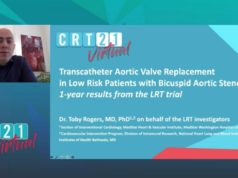
Three-year results from the COMPARE-ABSORB trial, presented during a late-breaking trial session at the 2021 Cardiovascular Research Technologies meeting (CRT 21 Virtual, 13 February–24 April), indicate that the Absorb (Abbott) bioresorbable scaffold resulted in a similar rate of target lesion failure (TLF) to the Xience (Abbott) metallic stent in patients at high risk of restenosis.
The trial compared the now-discontinued Absorb bioresorbable vascular scaffold (BVS) to the Xience metallic drug-eluting stent (DES) for the prevention of restenosis following percutaneous coronary intervention (PCI).
Absorb is a temporary scaffold design to treat coronary artery disease by restoring blood flow to the heart and then dissolving into the body. The device is made of polylactide, a naturally dissolvable material that is used in medical implants such as dissolving sutures. Abbott withdrew the device from the market in 2017, citing low commercial sales for the decision.
Presenting the results of the investigator-initiated study of the device, Peter Smits (Maasstad Hospital, Rotterdam, The Netherlands), commented that previous BVS trials have shown an increase in myocardial infarction and device thrombosis rates up to three-year follow-up.
The COMPARE ABOSRB study team hypothesised that the use of the Absorb BVS in a high-risk population for restenosis may demonstrate better long-term outcomes compared to a metallic DES after full resorption. Unlike other randomised studies of BVS, COMPARE ABSORB also mandated a dedicated optimal implantation technique from the start, Smits detailed.
Previous randomised trials with BVS showed an increase in myocardial infarction and device thrombosis rates up to three-year follow-up, Smits said, commenting that this was highly likely due to the intraluminal dismantling of the device during its resorption process.
Inclusion criteria for COMPARE ABSORB included patients with high-risk characteristics for restenosis, including known diabetes or multivessel disease, or complex de novo target lesion. A total of 1,670 patients were enrolled at 45 sites across Europe, who were randomised 1:1 to receive either the Absorb or Xience device.
Three-year rates of TLF stood at 8.9% in the Absorb arm, and 7.4% for those who received Xience, Smits explained. In terms of device thrombosis rates, these stood at 2.4% for Absorb and 1.1% for Xience. “These differences occur mainly in the early phase,” he commented.
Additionally, one-year landmark analysis showed similar rates of TLF, target vessel myocardial infarction and device thrombosis for both devices beyond one year. “Whether the absence of increased risk of very-late scaffold thrombosis and target vessel myocardial infarction was prevented by a dedicated implantation technique or prolonged DAPT [dual antiplatelet therapy] remains to be determined,” Smits commented.
Summing up the findings of the trial, Smits said that in a more-comer population at high risk for restenosis, TLF rates were not significantly different between the two devices after three years.
Follow-up of seven to 10 years will show whether the BVS has long-term advantages over the metallic Xience stent, Smits concluded.












